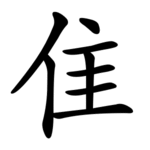隹
| ||||||||
| ||||||||
Translingual
[edit]| Stroke order (Sans-serif) | |||
|---|---|---|---|

| |||
| Stroke order | |||
|---|---|---|---|

| |||

Han character
[edit]隹 (Kangxi radical 172, 隹+0, 8 strokes, cangjie input 人土 (OG) or 難人土 (XOG), four-corner 20214/20215, composition ⿰亻⿱亠龶(GHT) or ⿰亻⿻主一(GHT) or ⿰亻⿳丿一龶(JK))
- Kangxi radical #172, ⾫.
Usage notes
[edit]This character is used mostly as a character component. Note that, in Japanese and Korean scripts, the dot stroke (㇔) atop the radical (隹) is written from top-right to bottom-left (instead of top-left to bottom-right) as found in the Kangxi dictionary.
Derived characters
[edit]- Appendix:Chinese radical/隹
- 倠, 准, 唯, 堆, 婎, 𡹐, 𡿾, 帷, 惟, 推, 淮, 猚, 陮, 進, 𢜐, 㫿, 椎, 𣨫, 㲝, 焳, 𤙵, 琟, 脽, 𤽼, 睢, 碓, 稚, 𧚮, 䊒, 維(维), 𫄻, 𦑏, 𬚟, 𦩏, 蜼, 𧣽, 誰(谁), 𧳞, 趡, 踓, 𨌴, 醀, 𨲈, 𪟦, 𪻉, 錐(锥), 𪹰, 䨀, 𩋘, 𩜑, 騅(骓), 魋, 䱦, 鵻, 𪍇, 𥽀, 𪏌, 𤒂, 䶆, 𪘮
- 𠃲, 𢽝, 𬆨, 𧡖, 顀, 䳡, 𪕪, 售, 𢛧, 𤊙, 焦, 𪂣, 奞, 寉, 崔, 萑, 㮅, 𫁒, 䍜, 𥯄, 𦋜, 翟, 霍, 瞿, 𫻼, 截, 㕍, 㢈, 痽, 𪋇, 龨, 閵(𫔴), 暹, 嵟, 奪, 奮
References
[edit]- Kangxi Dictionary: page 1364, character 5
- Dai Kanwa Jiten: character 41937
- Dae Jaweon: page 1867, character 22
- Hanyu Da Zidian (first edition): volume 6, page 4090, character 1
- Unihan data for U+96B9
Chinese
[edit]| simp. and trad. |
隹 | |
|---|---|---|
| 2nd round simp. | ⿰亻⿻二乚 | |
Glyph origin
[edit]Pictogram (象形) : a short‐tailed bird (e.g. a sparrow). Compare 鳥.
Etymology
[edit]Perhaps from Proto-Sino-Tibetan *twil; compare Tibetan མཆིལ་པ (mchil pa, “a little bird”) (Schuessler, 2007).
Cognate with 鵻 (OC *sɢʷinʔ, *tjul) "a kind of bird (turtle-dove?)" > 騅 (OC *tjul) "horse of that bird's color > horse of mixed grey and white color".
Pronunciation
[edit]- Mandarin
- (Standard Chinese)+
- Hanyu Pinyin:
- Zhuyin: ㄓㄨㄟ
- Tongyong Pinyin: jhuei
- Wade–Giles: chui1
- Yale: jwēi
- Gwoyeu Romatzyh: juei
- Palladius: чжуй (čžuj)
- Sinological IPA (key): /ʈ͡ʂu̯eɪ̯⁵⁵/
- (Standard Chinese)+
- Cantonese
- (Standard Cantonese, Guangzhou–Hong Kong)
- Jyutping: zeoi1
- Yale: jēui
- Cantonese Pinyin: dzoey1
- Guangdong Romanization: zêu1
- Sinological IPA (key): /t͡sɵy̯⁵⁵/
- (Standard Cantonese, Guangzhou–Hong Kong)
- Southern Min
- Middle Chinese: tsywij
- Old Chinese
- (Baxter–Sagart): /*tur/
- (Zhengzhang): /*tjul/
Definitions
[edit]隹
Compounds
[edit]Japanese
[edit]Kanji
[edit]Readings
[edit]Pronunciation
[edit]| Kanji in this term |
|---|
| 隹 |
| ふるとり Hyōgai |
| kun'yomi |
Noun
[edit]Note
[edit]- It is called "old" bird because it is contained in the character "舊"(old), to distinguish it from other bird radicals (鳥, 酉).
References
[edit]Korean
[edit]Hanja
[edit]隹 (eum 추 (chu))
- This term needs a translation to English. Please help out and add a translation, then remove the text
{{rfdef}}.
Vietnamese
[edit]Han character
[edit]- This term needs a translation to English. Please help out and add a translation, then remove the text
{{rfdef}}.
- CJK Unified Ideographs block
- Han script characters
- Kangxi Radicals block
- Han character radicals
- Translingual lemmas
- Translingual symbols
- Han pictograms
- Chinese terms inherited from Proto-Sino-Tibetan
- Chinese terms derived from Proto-Sino-Tibetan
- Chinese lemmas
- Mandarin lemmas
- Cantonese lemmas
- Hokkien lemmas
- Middle Chinese lemmas
- Old Chinese lemmas
- Chinese hanzi
- Mandarin hanzi
- Cantonese hanzi
- Hokkien hanzi
- Middle Chinese hanzi
- Old Chinese hanzi
- Chinese terms with IPA pronunciation
- Chinese terms spelled with 隹
- Chinese terms with obsolete senses
- Japanese kanji
- Japanese hyōgai kanji
- Japanese kanji with goon reading すい
- Japanese kanji with kan'on reading すい
- Japanese kanji with kun reading とり
- Japanese kanji with kun reading ふるとり
- Japanese terms spelled with 隹 read as ふるとり
- Japanese terms read with kun'yomi
- Japanese terms with IPA pronunciation
- Japanese lemmas
- Japanese nouns
- Japanese terms spelled with hyōgai kanji
- Japanese terms with 1 kanji
- Japanese terms spelled with 隹
- Japanese single-kanji terms
- ja:Chinese character components
- Korean lemmas
- Korean hanja
- Vietnamese lemmas
- Vietnamese Han characters
- CJKV radicals






















